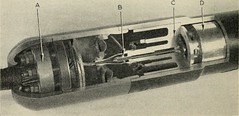
by Internet Archive Book Images
Transistors – A Perfect Solution for Amplifying Weak Electrical Signals
A transistor is a small electronic device that can cause changes in a large electrical output signal by small changes in a small input signal. That is, a weak input signal can be amplified by a transistor. A transistor consists of three layers of silicon or germanium semiconductor material. Impurities are added to each layer to create a specific electrical positive or negative charged behavior. “P” is for a positive charged layer and “N” is for a negative charged layer. Transistors are either NPN or PNP in the configuration of the layers. There is no particular difference except the polarity of voltages that need to be applied to make the transistor operate. The weak input signal is applied to the center layer called the base and usually referenced to ground which is also connected to the bottom layer called the emitter. The larger output signal is taken from the collector also referenced to ground and the emitter. Additional resistors and capacitors are required along with at least one DC power source to complete the transistor amplifier.
The transistor is the building block for modern electronic devices and preceded radios, calculators, computers, and other modern electronic systems. Inventors were actually awarded the Nobel Prize in 1956 for inventing the transistor. It can be argued that it is one of the most important inventions of the 20th century. In 2009, the first transistor invented by Bell Labs was named an IEEE Milestone. There are over a billion individual transistors that are produced each year (known as discrete transistors). However, a large majority are produced in integrated circuits along with diodes, resistors, capacitors, and other electronic components, comprising electronic circuits. Transistors can be used in a quantity of anywhere from 20 in logic gates to 3 billion in a microprocessor. Because of the low cost, flexibility, and reliability associated with the transistor, it has become extremely widely produced. To put things into perspective, there were 60 million transistors built for every person on Earth back in 2002. Now over a decade later, that number only continues to grow.
The two types of transistors are the bipolar transistor and the field-effect transistor, which have slight variations in terms of how they are utilized in a circuit. Transistors are usually used as electronic switches for both high-power and low-power applications. They can also be used as amplifiers in that a small change in voltage changes the small current through the base of the transistor. Some key advantages of transistors over other products are small size, minimal weight, no power consumption by a cathode heater, a warm-up period for cathode heaters required after power application, higher reliability, greater physical ruggedness, extremely long life, and insensitivity to mechanical shock and vibration, among others.
Top manufacturers for transistors are Maxim Integrated, Micro semi Power Products Group, NXP Semiconductors, ON Semiconductor, Panasonic Electronic Components, Rohm Semiconductor, Sanken, SANYO Semiconductor Corporation, STMicroelectronics, and Toshiba.
If you Google for best transistor components you will get many one stop shops for any transistor parts you are looking for, regardless of who manufactures it or what the purpose is.
